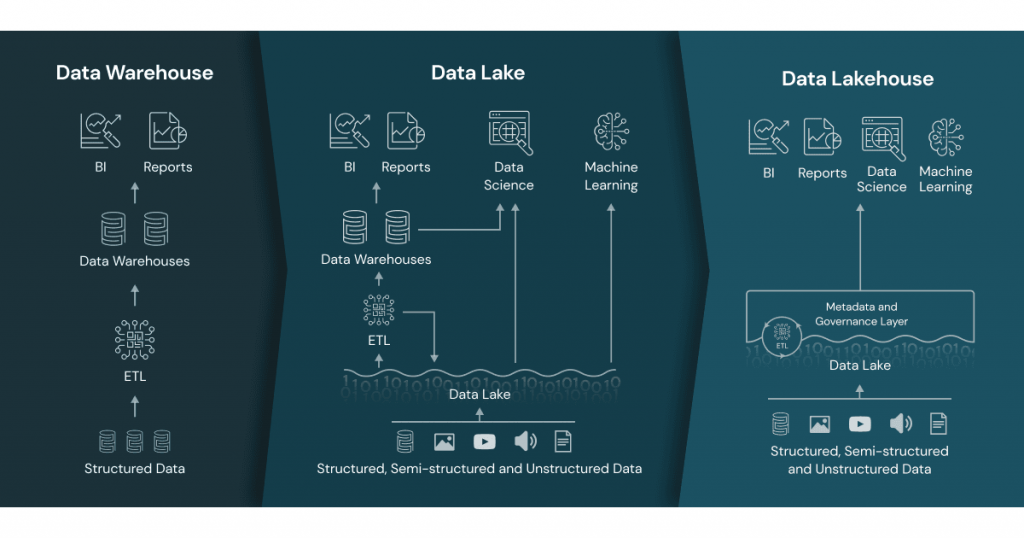Key Takeaways
- Understanding Data: Data is the liveblood of modern operations and decision-making.
- Data Storage and Architecture: Organizing data and processing is vital for deriving accurate insights.
- Data Warehouses: Traditional, for structured data, can be computationally expensive at scale.
- Data Lakes: A flexible, cost-effective, and scalable, not suitable for real-time applications.
- Data Lakehouses: A modern hybrid that combines the best features of data lakes and warehouses, offering flexibility, scalability, cost-efficient, and real-time enabled.
- The Future of Data: Data Lakehouses are changing the landscape of data-driven operations, offering new capabilities, insights, and opportunities.
What is Data Lakehouse?
Imagine if you could have the structure of the library and the freedom of the attic in one place. That’s the data lakehouse! It’s like being able to grab your Italian cookbook and your family photo album from the same shelf without any fuss.
A data lakehouse combines the flexibility of data lakes with the order and structure of data warehouses. This hybrid approach provides organizations with a powerful tool that can handle diverse data types while maintaining a high level of organization and compliance. Imagine a vivid infographic below, illustrating the journey from the structured organization of Data Warehouses, through the fluid flexibility of Data Lakes, and finally arriving at the harmonious blend that is the Data Lakehouse.

Image: databricks.com/glossary/data-lakehouse
A Gentle Introduction to Data
Data is the core of our digital world, like the ABCs of a language. Just as we use letters to form words, sentences, and stories, data is the basic building block of information. Imagine it as the individual pixels that make up a vivid picture on your computer screen. These tiny pieces come together to form the larger image we see, but instead of a picture, data combines to provide valuable insights. Whether numbers, texts, images, or videos, data is everywhere, and it’s the language our modern world speaks.
Data is the fuel that powers everything from our smartphones to global corporations. It helps doctors make better diagnoses, businesses offer personalized services, and governments create informed policies. Without data, our world would be akin to a novel without words or a painting without colors.
Foundations of Storage and Architecture
Storing data is a lot like organizing books on a bookshelf. Imagine each book as a container of information, much like a file or database in the digital realm. Just as you carefully place each book on a shelf to find and retrieve it later, data storage works on the same principle. A messy bookshelf where you can’t find what you need is as unhelpful as a disorganized database. Thus, the foundation of storage and architecture plays a critical role in making data usable.
Understanding how data is stored is similar to knowing the layout of a library. From structured databases resembling neatly arranged shelves to more complex and free-form repositories, akin to a grand attic filled with treasures, the choice of storage affects how easily we can access and use the information.
Traditional Data Warehouse
The data warehouse is like a meticulously organized library, great for specific purposes. This method has worked for businesses for decades, especially when data was primarily structured, like those well-organized novels. However, as the diversity of data types grew, this method started to show limitations.
The Data Lake
But then, along came the age of Big Data, with unstructured information like pictures, videos, or sound recordings. That’s where the data lake comes in, a place where unstructured information can be stored in its raw format, just like an attic where you keep unsorted treasures.
The data lake provided a revolutionary solution, allowing organizations to store vast amounts of raw, unfiltered data. It was like opening the door to an attic filled with unsorted boxes, each one containing potential insights and discoveries. This new approach provided flexibility but also brought challenges.
The Limitation of Data Lakes
The data lake, although powerful, is not ready for immediate consumption. This can lead to difficulties in governance, privacy, and technical complexities. It’s like trying to find a special photo in an attic filled with unmarked boxes; it’s possible but very difficult and time-consuming.
Without proper management, a data lake can quickly turn into a data swamp, filled with disorganized and unusable information. It can be related to trying to find a specific book in an attic filled with unmarked boxes, each containing a jumble of various items. The potential is there, but the chaos can make it almost impossible to extract value.
The Comparisons
|
Feature |
Data Lakes |
Data Warehouses |
Data Lakehouses |
|
Flexibility |
High |
Medium |
High |
|
Organization |
Low |
High |
High |
|
Data Types Supported |
All (structured and unstructured) |
Structured (mostly) |
All (structured and unstructured) |
|
Cost |
Generally low |
Can be high |
Cost Effective |
|
Ease of Use |
Can be challenging |
Easier (for structured data) |
Easier at scale (for both structured and unstructured) |
|
Governance and Compliance |
Can become messy (Data Swamp) |
Well-governed |
Intelligent metadata handling; automated compliance |
|
Use cases |
Large-scale storage, raw data analysis |
Reporting, analytics, business intelligence |
All in Data Warehouse, plus AI/ML and Real-time at scale |

